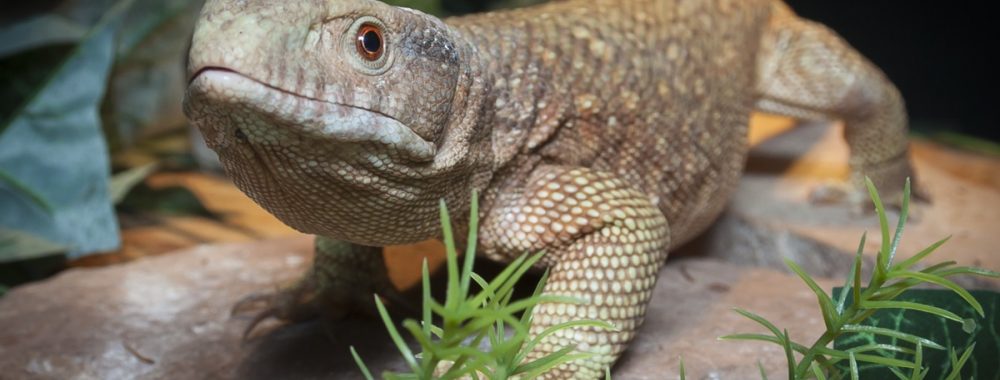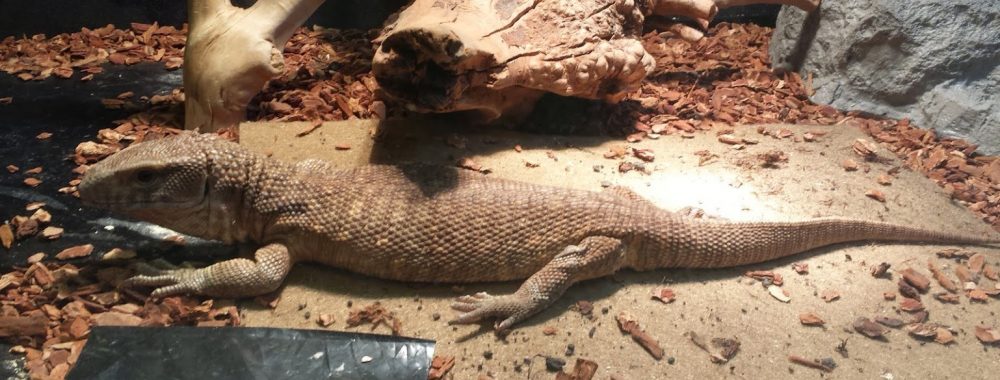Zilla
Fast Facts
- Class: Reptilia
- Order: Squamata
- Family: Varanidae
- Genus/Species: Varanus exanthematicus
Other members of the Varanidae Family include: Komodo Dragon of Indonesia, and goannas of Australia and SE Asia

Lifespan
8-10 years in the wild; 15-20 in captivity
Natural Habitat
Dry and hot Western and eastern central sub-Saharan African grasslands
Features
Ranging in size from 2-5 feet long (females much smaller than males), thick and stocky with relatively short limbs. Coloration varies depending on habitat and they can be striped or spotted. The Monitor's tongue is long, forked and blue, and their trachea (wind pipe) extends all the way up to right behind the front mandibular (lower) teeth. This adaptation allows them to literally fill their throat with a large meal while still being able to breathe. They can also dislocate their hyoid (a bone that is underneath the base of the tongue) in order to enlarge their throat and swallow prey whole. During the wet season (generally about 8 mos.) when prey is much more plentiful they can consume almost one tenth of their body weight in a single day! During the remainder of the year (dry season) they are fasting and can live off the fat reserves built up over the "feast season".
Diet
Carnivore: an excellent predator, hunting in cooler daylight hours (diurnal) a large variety of insects, birds, rodents, other reptiles, amphibians, snails and eggs; at TSZ Zilla is fed adult mice (thawed from frozen and warmed) and superworms.
Fun Facts
- The name "Monitor" comes from the local belief that the Nile Monitor Lizard watched for crocodiles along the banks of the Nile River and warned people when they were nearby; in reality, the lizards were likely drawn to the area to forage for crocodile eggs, an apparent favored meal!
- Their teeth and jaws are adapted to be able to crush snail shells, so avoiding an accidental bite is essential!
- When "flicking" their long forked tongues, they are "tasting" the air which helps to locate prey and also to find a mate during breeding season.
- They have evolved a unique behavior that allows them to eat poisonous millipedes: they rub their chins on the millipede for up to FIFTEEN minutes, which causes the millipede (in its defense) to excrete all its poison, and then be eaten without danger to the Monitor!
- Males are very territorial - they will hiss, thrash their tales and inflate their throats to dissuade others from approach. When threatened by predators if these tactics don't work, they will attack thrashing and biting; and if this is not successful they have been known to play dead and excrete foul smelling fecal matter.
- Zilla serves as an ambassador for his species, which is hunted for leather and meat and for the international pet trade: between the years 2000-2009 alone 30,000 live monitors were imported into the US while during that same period over 1,000 skins, shoes, hand bags, and other products from this species were imported into the US. How to help? - Don't buy products made from reptile skins!!
Puzzle Time!
Have fun completing this puzzle of our very own Zilla!



We love meeting new people!